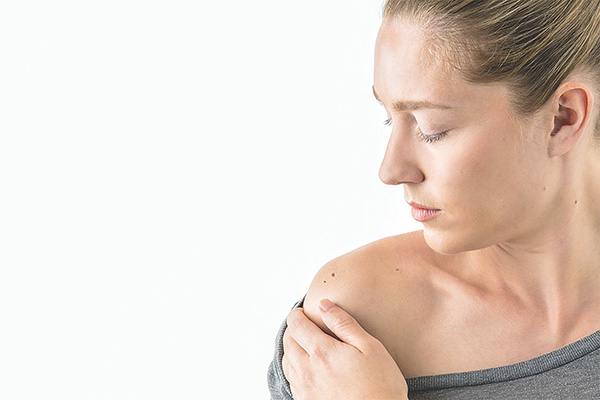
By Judy O’Gorman Alvarez
Eileen Fell knew her fair skin, Irish heritage and time in the sun made her at risk for skin cancer, but that was not what brought her to the dermatologist’s office last November. It was a rash she developed after breast cancer reconstruction surgery that was not healing. “It turned out I was allergic to the adhe- sives in the bandage.”
But while she was there she asked the doctor to take a look at a freckle on her back she had only recently noticed. “It was dark – and it was new.”
The doctor took one look and insisted on taking a sample to biopsy.
It turned out to be a malignant melanoma in situ, which is also called stage 0 melanoma. It was cancer, but the cancer had not spread.
“I’m of Irish heritage. I’m freckly. I had radiation in March of 2020,” said Fell of Spring Lake Heights. “And it’s very hard to put suntan lotion on your back.”
Skin cancer, an out-of-control growth of abnormal cells in the epidermis – the outer- most skin layer – is caused by unrepaired DNA damage that triggers mutations. Ac- cording to the Skin Cancer Foundation, those mutations lead the skin cells to multiply rapidly and form malignant tumors. It is estimated that 1 in 5 Americans will develop skin cancer by the age of 70.
Years of sun worshiping in youth doesn’t help anyone. Fell recalls bad sunburns in her teenage years. “I remember being absolutely miserable.” She tried homemade remedies like used tea bags applied to eyelids, all to find some sort of relief.
But the first bad sunburn of the season was almost a rite of passage. “We thought you had to burn before you would tan,” she said.
“In college we would line our Steely Dan albums with tinfoil and sit on the front lawn of our dorm and burn.”
When physicians removed the melanoma from Fell, resulting in 15 stitches, the margins were all clear, which meant the cancer had been removed. A month later they found and removed another growth, but that turned out to be a melanocytic naevus, or an unusual mole.
Nowadays, Fell still enjoys the sunshine, but can be found wearing a long-sleeved shirt while playing tennis, applying sunblock with a 70 SPF – not forgetting her hands – and limiting her time on the beach.
“I’m a firm believer of sunblock,” she said, “I wear a hat for walking and playing tennis. I sit under an umbrella – or in the shade.”
There are three main types of skin cancer: basal cell carcinoma, squamous cell carcinoma and melanoma. (A fourth type, Merkel cell carcinoma, is very serious but extremely rare.)
“Basal cell is the most common but least dangerous,” said Kenneth A. Grossman, M.D., of Little Silver Dermatology LLC.
“Cancer has to be spread locally and cause tissue damage locally and spread to other parts of body” to be overly concerning, he said. “Basal cell doesn’t do that – but it must be treated.”
Unlike some cancers, basal cell has no precancerous symptoms; there are no suspicious moles to watch.
“Squamous is a little more aggressive and usually does spread,” he said. It occurs when DNA damage from exposure to ultraviolet radiation or other damaging agents triggers abnormal changes in the squamous cells.
The rough, scaly patches on the skin that develop from years of sun exposure – actinic keratoses – are very common. “It is so common that if I see 35 patients in a day, a third of them will have come in and that was one of the reasons,” he said.
“Melanoma is potentially the deadliest form” of skin cancer, he said. Although most people think it starts with a preexisting mole, he said, that’s not always the case. “But it can be seen in people who have a lot of moles.”
According to Grossman, the most common places men develop skin cancer is the upper back; for women, the lower leg. But he cautions a common misconception about melanoma is that it occurs only in sun-exposed areas of the skin. He has diagnosed skin cancer in places such as the armpit, between the toes and other areas where patients may not be inspecting during self-exams.
Years ago, Grossman said, a study said 80 percent of the skin’s damage from sun occurs before age 18. “Well, someone went back and looked at that and did the math,” he said. “It turns out it’s only about 25 percent of sun exposure. The rest is afterward.”
For those who have seen the light – ultraviolet and other types – choosing to lather up the sunscreen and limit time in the sun, there are steps one can take to reduce the risk of skin cancer.
“You can wear protective clothing,” he said. Now there are manufacturers making clothing like hats and shirts with SPF components woven in.
Grossman also suggests staying out of the sun at peak sun burning times. “I used to tell people avoid between 11 and 2,” he said. “But now I tell people 10 to 4. And use sunblock of at least SPF 30.”
About that sunblock. “Studies have shown that chemicals in sunscreens have been found in the bloodstream,” he said. Although the jury is out on how relevant that is, Grossman said he recommends sunscreens with zinc oxide and titanium instead of chemicals. These mineral sunscreens are also better for the environment.
“And reapply every two hours or after going in the water or sweating,” he said.
For those who worry about those sun-drenched days of the past, there may be something they can do. Grossman said he recommends Heliocare, an over-the-counter dietary supplement. “It helps prevent and can undo sun damage.”
Skin checks by a dermatologist every one or two years is recommended for those without a strong family history of cancer and who have never had a precancerous growth or skin cancer.
Although some may feel the younger generation may be catching on to the dangers of sun tanning – if not only to prevent skin cancer, but to avoid wrinkles – Grossman said he didn’t think they’re getting the message.
“And tanning beds are just a no-no,” he said.
Indoor tanning, such as tanning beds, don’t of fer a safe alternative to sunlight. The Skin Cancer Foundation found in a study that of 63 women diagnosed with melanoma before age 30, 61 of them – 97 percent – used tanning beds.
People of color are not exempt from skin cancer, either, but cases are far fewer. Unfortunately, skin cancer in patients with darker skin tones is often diagnosed in its later stages and more difficult to treat.
As Grossman notes, his skin cancer patients are usually fair-skinned. “This area is populated by Irish Celtic people who live at the Jersey Shore,” he said. “And they shouldn’t.”
Bottom line, said Grossman: “No amount of sun exposure is OK.”
This article originally appeared in the June 3, 2021 print edition of The Two River Times.














